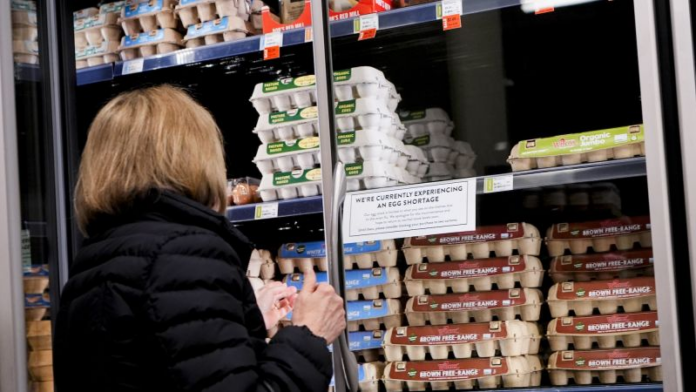CNN —
It’s not just eggs.
Many commonly purchased goods and services got more expensive in January, driving inflation in the wrong direction and to its highest rate since June of last year.
Consumer prices rose 0.5% from December — the fastest pace since August 2023 — resulting in an annual inflation rate of 3% for the 12 months that ended in January, according to the latest Consumer Price Index data released Wednesday by the Bureau of Labor Statistics.
Economists were expecting Wednesday’s report to be fairly unexciting, with barely any change from December’s data.
Instead, the January report came in hot pretty much across the board — an unwelcome surprise at a time when the cost of living continues to weigh on Americans, the Federal Reserve is wanting to see inflation slow, and uncertainty is brewing as to how President Donald Trump’s heavy-handed tariffs and other policies could affect prices.
“The long national nightmare of inflation isn’t over yet for consumers, businesses, and investors,” Chris Rupkey, chief economist at FwdBonds, wrote in commentary issued Wednesday morning. “There could be some seasonality that pushes prices up at a faster clip in January, but today the news for [Federal Reserve] officials is all bad.”
US stocks dropped Wednesday, with investors concerned that inflation has reversed its recent progress and could lead to higher interest rates. The Dow was around 395 points lower at the opening bell, with the S&P 500 down 1% and the Nasdaq Composite declining by 1.1%. The 10-year Treasury yield surged to 4.6% on the hotter-than-expected data.
Eggs rise at fastest rate in nearly 10 years
January CPI reports can tend to run a little warm as they reflect start-of-year price adjustments for many businesses. However, Wednesday’s report was hot across the board.
The CPI measures price changes across commonly purchased goods and services, and most of the categories saw increases last month.
Energy and food costs continued to bite — that’s particularly true for eggs, which have seen prices soar and widespread shortages as a result of a deadly avian flu.
Egg prices, which are up 53% year over year, shot up 15.2% from December to January. That’s the biggest monthly increase that index has seen since June 2015 (when prices rocketed 18.3% as a Highly Pathogenic Avian Influenza outbreak intensified).
Grocery prices jumped 0.5% from December — the fastest they’ve risen on a monthly basis in more than two years. (The egg index accounted for two-thirds of that increase, the BLS noted).
Economists were expecting inflation to pick up 0.3% from December, keeping the annual rate at 2.9%, according to FactSet consensus estimates.
Food and energy can be quite volatile and influenced heavily by circumstances such as weather, disease, supply chain challenges and global strife. So economists look to a “core” index of CPI, which strips out food and energy, as a way to gauge progress on underlying inflation.
Even core moved higher in January: It jumped 0.4% on a monthly basis, bringing the annual rate up to 3.3% from 3.2%.
Still, core has hovered between 3.2% and 3.3% for eight months now, said Oak McCoy, an economist and assistant professor at the University of New England.
“It seems to be a mixed bag for [the Fed],” McCoy told CNN. “We see a lot of these core categories that are on the rise; but overall, it seems to be fairly stable.”
Core has remained particularly sticky and stubborn because of shelter inflation, a category that measures housing-related price changes (albeit in an amorphous and lagging way).
Shelter prices accelerated last month, rising 0.4% versus 0.3% in December; however, those gains were driven by substantial increases in home insurance and lodging-away-from-home, categories that are typically volatile, noted Josh Hirt, senior US economist at Vanguard.
Still, on an annual basis, shelter inflation continued to cool, dipping to 4.4%, matching a three-year low.
Inflation has slowed significantly since hitting a 40-year high in 2022. However, prices are still rising faster than Americans were used to in the decade before the pandemic, underscoring the challenges ahead for Trump.
They’re also moving in the opposite direction of the Fed’s target.
‘Grappling with uncertainties’
While data can be volatile on a monthly basis, economists cautioned that the current trajectory could keep the central bank on the sidelines this year. That would mean interest rates remaining high for consumers and businesses.
That’s not what Trump wants to see.
“Interest Rates should be lowered, something which would go hand in hand with upcoming Tariffs!!! Lets Rock and Roll, America!!” Trump posted Wednesday on his TruthSocial platform prior to CPI’s release.
Trump’s comments were more about the administration’s policy actions versus “jawboning” the Fed, Kevin Hassett, director of the White House National Economic Council, told CNN’s Phil Mattingly on Wednesday.
“We’re taking aggressive actions to lower interest rates,” Hassett said.
Noting a recent drop in the 10-year Treasury yield, Hassett added that the “macroeconomic policies of President Trump are already working.” However, the 10-year Treasury yield surged Wednesday after the hotter-than-expected inflation report.
In addition to “getting spending under control,” the Trump administration’s supply-side tax cuts, regulatory policies and desire to increase domestic drilling could reduce prices further, said Hassett, who blamed the acceleration in inflation on the Biden administration.
He also told Mattingly that the Trump administration will soon announce plans to get “egg prices under control.”
Still, other key policies of the administration run the risk of driving prices higher, economists say.
Mainstream economists largely agree that Trump’s tariff plan will reignite inflation and slow US economic growth.
“There is nothing in the tariff agenda that will make prices lower for consumers,” Stephanie Roth, chief economist at Wolf Research, told CNN.
Rising inflation and a slowing of economic growth would be a harsh cocktail in an environment where the Federal Reserve has limited tools — and blunt ones at that — to combat rising inflation.
Raising interest rates is meant to help curb demand and slow down price hikes. However, as Americans have witnessed for the past three years, it’s a delicate dance to achieve a more stable price environment without cratering the economy into a recession (a “soft landing”).
That landing remains in sight, but the latest data — coupled with still-strong labor market and consumer spending activity — could keep the Fed in a holding pattern.
“There’s a déjà vu element here — 2024 also started with a few hot inflation prints that forced a big reassessment of rate-cutting expectations,” Elyse Ausenbaugh, head of investment strategy at J.P. Morgan Wealth Management, wrote Wednesday. “We have already been grappling with uncertainties surrounding trade and fiscal policy this year, and I continue to trust the Fed’s patient and data-dependent approach to deciding when it might be appropriate to make another move.”



